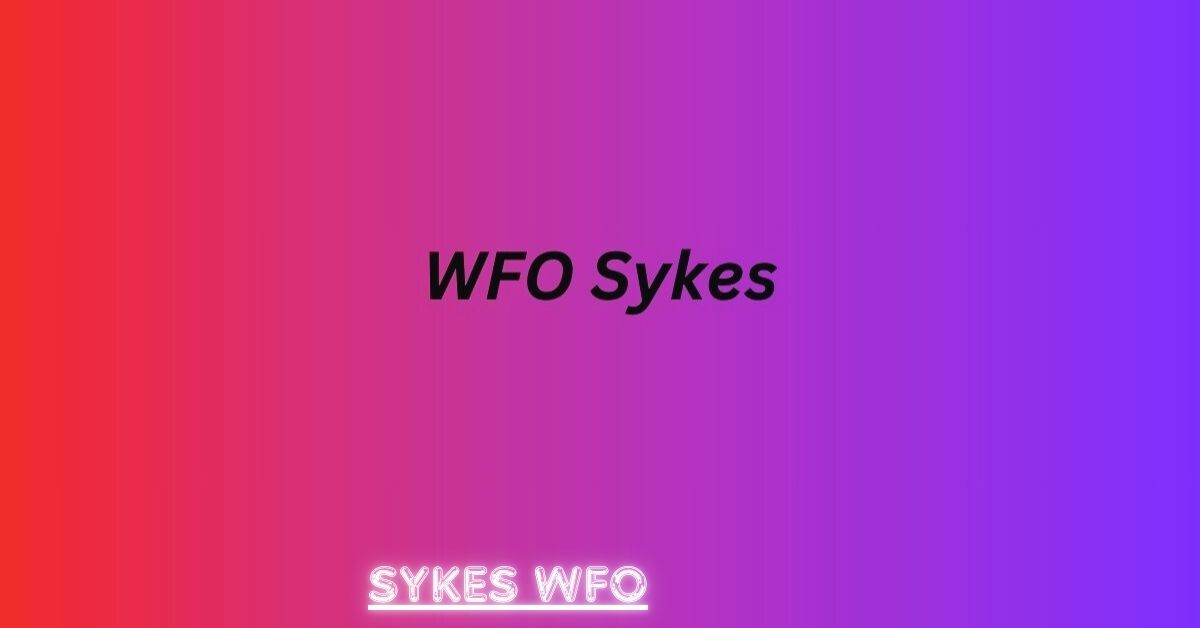Introduction
The landscape of work environments has evolved significantly over the past few decades. Among the companies leading the way in workplace transformation is Sykes, renowned for its innovative approach to employee management and operational efficiency. Sykes WFO, or Sykes Work From Office, represents the company’s latest strategy in adapting to the modern workplace, balancing flexibility with operational effectiveness.
The Concept of Work From Office (WFO)
Work From Office (WFO) is a workplace strategy that emphasizes employees working from a designated office location rather than remotely. This approach contrasts with the Work From Home (WFH) model, which gained prominence during the COVID-19 pandemic. Sykes’ adaptation of the WFO model integrates contemporary workplace practices to enhance productivity and employee engagement.
Sykes’ Approach to WFO
Sykes has implemented a structured WFO strategy designed to maximize efficiency while accommodating the needs of a modern workforce. This strategy includes flexible office layouts, advanced technology integration, and a focus on employee well-being. The company’s approach aims to create an environment that fosters collaboration, innovation, and job satisfaction.
Key Features of Sykes WFO Strategy
Flexible Workspaces
One of the cornerstones of Sykes’ WFO strategy is the design of flexible workspaces. These workspaces are designed to be adaptable, allowing employees to switch between collaborative areas and individual workstations. This flexibility supports various work styles and preferences, promoting a dynamic and engaging office environment.
Advanced Technology Integration
Sykes places a strong emphasis on integrating advanced technology within its offices. This includes the use of high-speed internet, cloud-based collaboration tools, and state-of-the-art communication systems. The goal is to create a seamless and efficient work environment where technology enhances productivity rather than complicates it.
Employee Well-Being
Employee well-being is a priority in Sykes’ WFO strategy. The company provides ergonomic office furniture, wellness programs, and mental health support to ensure that employees remain healthy and engaged. By prioritizing well-being, Sykes aims to reduce burnout and increase job satisfaction.
Collaborative Spaces
Collaborative spaces are integral to Sykes’ WFO model. These areas are designed to facilitate teamwork and brainstorming sessions, equipped with tools and resources to support group activities. The focus is on creating environments that encourage open communication and creative problem-solving.
Personalization and Autonomy
Sykes promotes personalization and autonomy within its WFO strategy. Employees have the freedom to personalize their workspaces and choose how they work best. This approach empowers employees to take ownership of their work environment, leading to increased motivation and productivity.
Health and Safety Protocols
In response to health concerns, Sykes has implemented comprehensive health and safety protocols in its offices. These include regular cleaning, social distancing measures, and health screenings. The company aims to create a safe work environment where employees feel comfortable and secure.
Benefits of Sykes WFO Strategy
Enhanced Collaboration
By focusing on collaborative spaces and advanced technology, Sykes’ WFO strategy enhances teamwork and communication. Employees can easily connect with colleagues, share ideas, and work together on projects, leading to more effective and innovative solutions.
Increased Flexibility
The flexibility of Sykes’ office spaces allows employees to adapt their work environment to their needs. This flexibility can lead to improved job satisfaction and productivity, as employees can choose the workspace that best suits their tasks and preferences.
Improved Employee Well-Being
Sykes’ focus on employee well-being contributes to a positive work environment. By providing ergonomic furniture, wellness programs, and mental health support, the company helps employees maintain their health and work-life balance, reducing stress and burnout.
Better Work-Life Balance
The flexibility inherent in Sykes’ WFO strategy can contribute to a better work-life balance. Employees can manage their work environment in a way that supports their personal and professional lives, leading to increased overall satisfaction.
Operational Efficiency
Advanced technology and flexible workspaces contribute to operational efficiency. Employees can work more effectively, collaborate seamlessly, and access the resources they need, resulting in improved performance and productivity.
Challenges and Considerations
Transition Period
Implementing a new WFO strategy can involve a transition period. Employees may need time to adjust to new work environments and practices, and the company must manage this change effectively to minimize disruption.
Technology Dependence
While advanced technology is a key component of Sykes’ WFO strategy, it also introduces dependence on technological systems. Ensuring that these systems are reliable and secure is crucial for maintaining productivity and protecting sensitive information.
Balancing Flexibility and Structure
Finding the right balance between flexibility and structure can be challenging. Sykes must ensure that its flexible workspaces do not compromise organizational efficiency and that employees remain accountable while enjoying the benefits of autonomy.
Health and Safety Compliance
Maintaining health and safety standards requires ongoing vigilance. Sykes must continuously update and enforce protocols to ensure a safe work environment, addressing any emerging health concerns promptly.
Future Trends in WFO
Hybrid Work Models
The future of workplace strategies may involve hybrid models that combine elements of both WFO and WFH. This approach allows for greater flexibility while maintaining the benefits of office collaboration.
Enhanced Technology Integration
As technology continues to evolve, future WFO strategies may incorporate even more advanced tools and systems. Innovations in virtual reality, artificial intelligence, and automation could further enhance the work environment.
Focus on Sustainability
Sustainability is becoming an increasingly important consideration in workplace strategies. Sykes may integrate eco-friendly practices and energy-efficient technologies into its WFO model to align with broader environmental goals.
Case Studies and Examples
Sykes’ Global Offices
sykes wfo global offices provide diverse examples of its WFO strategy in action. These offices showcase how the company adapts its approach to different cultural and operational contexts, highlighting the flexibility and effectiveness of its WFO model.
Employee Testimonials
Employee testimonials offer valuable insights into the impact of Sykes’ WFO strategy. Positive feedback from employees can illustrate the benefits of the model, while constructive criticism can inform ongoing improvements.
Conclusion
sykes wfo From Office (WFO) strategy represents a forward-thinking approach to workplace management. By integrating flexible workspaces, advanced technology, and a focus on employee well-being, Sykes is setting a new standard for modern office environments. While challenges exist, the benefits of this strategy—including enhanced collaboration, increased flexibility, and improved employee satisfaction—demonstrate its potential to transform the way we work. As the workplace continues to evolve, Sykes’ WFO strategy will likely play a significant role in shaping the future of work.
Read More: Esfeet: Revolutionizing Personal Health Monitoring
